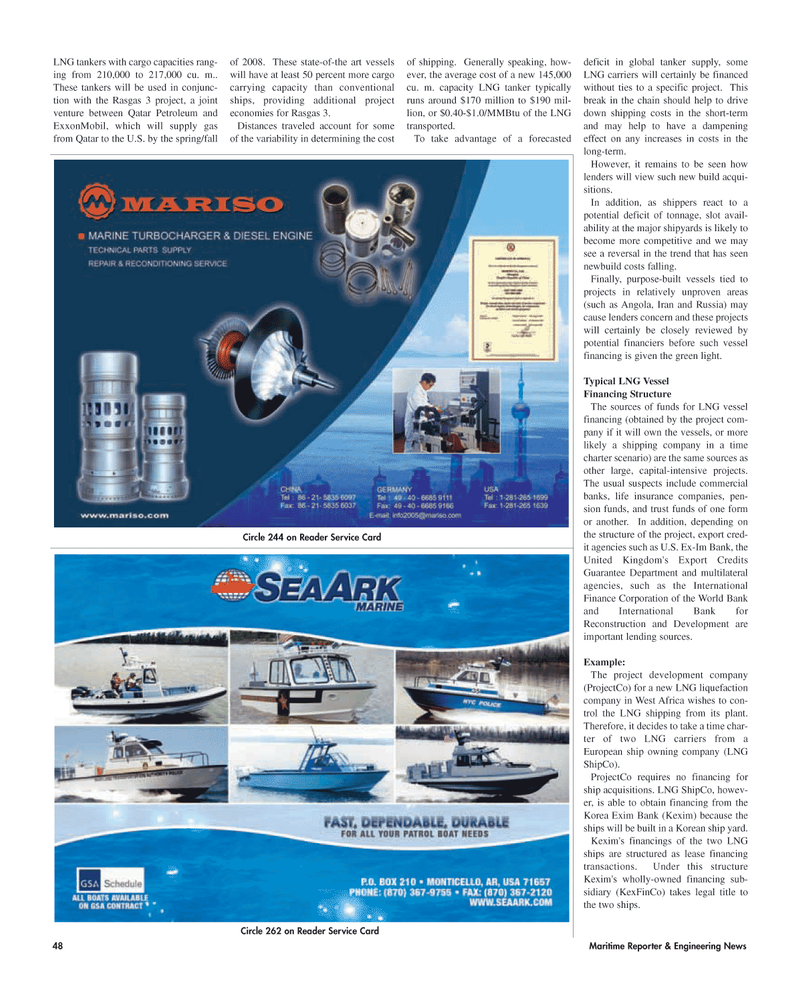
Page 48: of Maritime Reporter Magazine (May 2006)
The Marine Enviroment
Read this page in Pdf, Flash or Html5 edition of May 2006 Maritime Reporter Magazine
48 Maritime Reporter & Engineering News
LNG tankers with cargo capacities rang- ing from 210,000 to 217,000 cu. m..
These tankers will be used in conjunc- tion with the Rasgas 3 project, a joint venture between Qatar Petroleum and
ExxonMobil, which will supply gas from Qatar to the U.S. by the spring/fall of 2008. These state-of-the art vessels will have at least 50 percent more cargo carrying capacity than conventional ships, providing additional project economies for Rasgas 3.
Distances traveled account for some of the variability in determining the cost of shipping. Generally speaking, how- ever, the average cost of a new 145,000 cu. m. capacity LNG tanker typically runs around $170 million to $190 mil- lion, or $0.40-$1.0/MMBtu of the LNG transported.
To take advantage of a forecasted deficit in global tanker supply, some
LNG carriers will certainly be financed without ties to a specific project. This break in the chain should help to drive down shipping costs in the short-term and may help to have a dampening effect on any increases in costs in the long-term.
However, it remains to be seen how lenders will view such new build acqui- sitions.
In addition, as shippers react to a potential deficit of tonnage, slot avail- ability at the major shipyards is likely to become more competitive and we may see a reversal in the trend that has seen newbuild costs falling.
Finally, purpose-built vessels tied to projects in relatively unproven areas (such as Angola, Iran and Russia) may cause lenders concern and these projects will certainly be closely reviewed by potential financiers before such vessel financing is given the green light.
Typical LNG Vessel
Financing Structure
The sources of funds for LNG vessel financing (obtained by the project com- pany if it will own the vessels, or more likely a shipping company in a time charter scenario) are the same sources as other large, capital-intensive projects.
The usual suspects include commercial banks, life insurance companies, pen- sion funds, and trust funds of one form or another. In addition, depending on the structure of the project, export cred- it agencies such as U.S. Ex-Im Bank, the
United Kingdom's Export Credits
Guarantee Department and multilateral agencies, such as the International
Finance Corporation of the World Bank and International Bank for
Reconstruction and Development are important lending sources.
Example:
The project development company (ProjectCo) for a new LNG liquefaction company in West Africa wishes to con- trol the LNG shipping from its plant.
Therefore, it decides to take a time char- ter of two LNG carriers from a
European ship owning company (LNG
ShipCo).
ProjectCo requires no financing for ship acquisitions. LNG ShipCo, howev- er, is able to obtain financing from the
Korea Exim Bank (Kexim) because the ships will be built in a Korean ship yard.
Kexim's financings of the two LNG ships are structured as lease financing transactions. Under this structure
Kexim's wholly-owned financing sub- sidiary (KexFinCo) takes legal title to the two ships.
Circle 262 on Reader Service Card
Circle 244 on Reader Service Card
MR MAY2006 #6 (41-48).qxd 5/8/2006 12:01 PM Page 48

 47
47

 49
49
